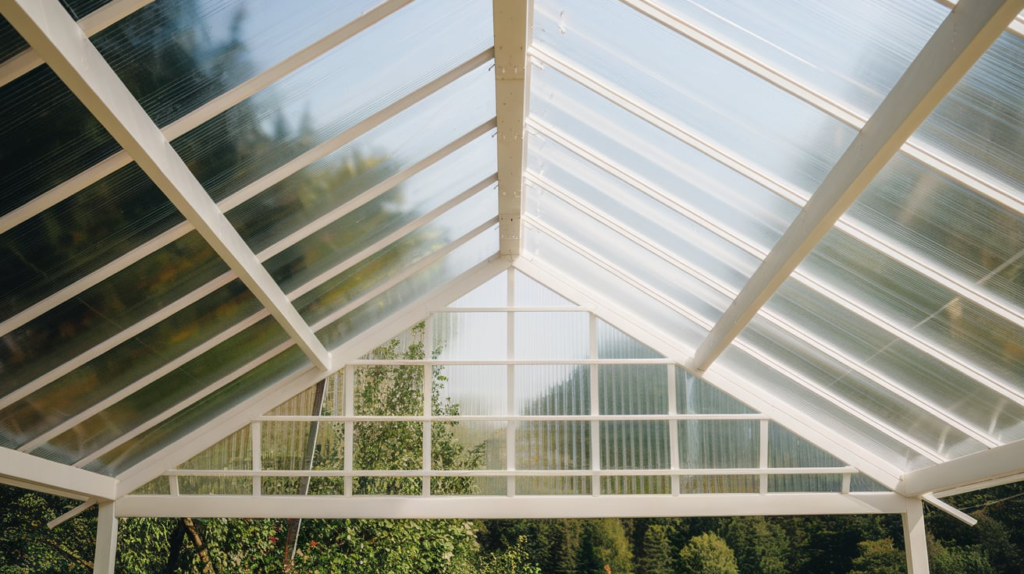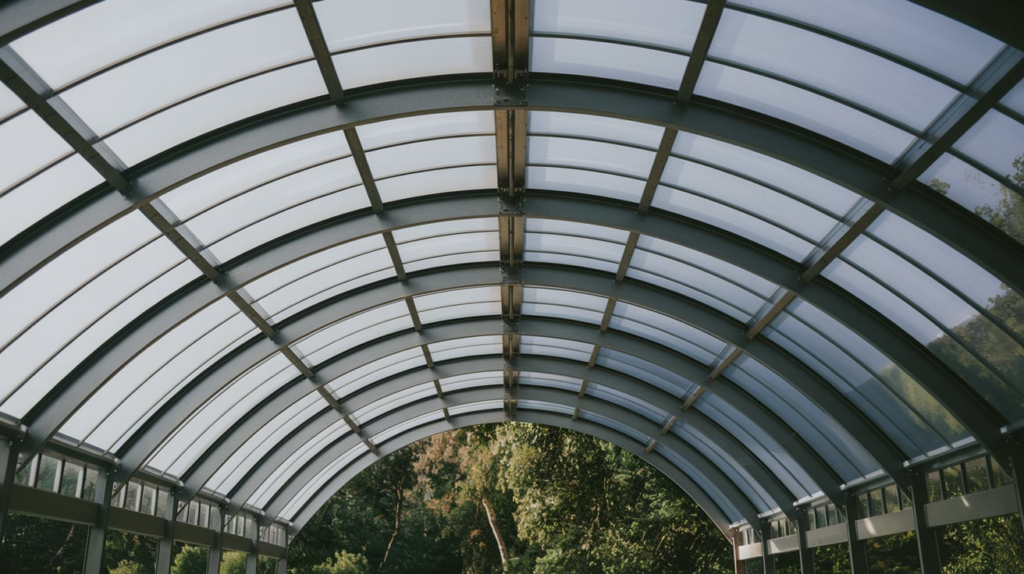Polycarbonate roofing is a popular choice for Filipino homes because it combines durability, versatility, and style. Whether you’re covering a garage, patio, greenhouse, or part of your home, polycarbonate roofing provides excellent protection from the sun and rain while allowing natural light to filter through.
This roofing material is lightweight, easy to install, and highly resistant to impact and weather. If you’re planning a polycarbonate roofing installation, this step-by-step guide will help you achieve the best results.

What Is Polycarbonate Roofing?
Polycarbonate roofing is made from polycarbonate plastic, a strong and lightweight material known for its high durability and UV resistance. It is commonly used for:
• Residential patios and verandas
• Garages and carports
• Greenhouses and garden covers
• Skylights and roofing panels for commercial spaces
Polycarbonate roofing comes in two main types:
1. Solid Polycarbonate Sheets: Clear or tinted, resembling glass but much lighter and stronger.
2. Corrugated Polycarbonate Sheets: Wavy or ribbed sheets that are perfect for structures requiring added strength.
Tools and Materials Needed for Polycarbonate Roofing Installation
Before starting the installation, make sure you have all the necessary tools and materials:
Tools
• Measuring tape
• Power drill or screwdriver
• Circular saw or fine-tooth hand saw
• Roofing screws and washers
• Ladder or scaffolding
• Safety gear (gloves, helmet, and goggles)
• Chalk line
Materials
• Polycarbonate sheets (solid or corrugated)
• H-profile or U-profile connectors (for joining sheets)
• Roofing screws with rubber washers
• Flashing (aluminum or polycarbonate)
• Sealant or silicone adhesive
Step-by-Step Guide to Installing Polycarbonate Roofing
Follow these simple steps to ensure a proper polycarbonate roofing installation:
1. Plan and Measure Your Roof
• Start by measuring the area you want to cover.
• Determine how many polycarbonate sheets you need based on the roof dimensions.
• Allow for an overlap of 50mm between sheets to prevent water leaks.
2. Prepare the Framework
• Build a sturdy framework using wood or metal purlins.
• The distance between the supports should be no more than 1 meter for corrugated sheets and 0.6 meters for solid sheets to prevent sagging.
• Make sure the framework is level and securely installed.
3. Cut the Polycarbonate Sheets
• If needed, cut the sheets to the required size using a circular saw with a fine-tooth blade or a hand saw.
• Avoid using rough blades, as they can damage the edges of the polycarbonate sheets.
• Always cut the sheets with the UV-protected side facing up to prevent scratching.
4. Drill Holes for Roofing Screws
• Pre-drill holes for the screws using a drill bit slightly larger than the screw diameter (about 3mm bigger).
• Space the holes at about 300-400mm intervals along the sheets.
• Make sure holes are drilled at the peaks (ridges) for corrugated sheets to prevent leaks.
5. Install the Polycarbonate Sheets
• Start installing the sheets from one side of the roof and work your way across.
• Place the sheets with the UV-protected side facing up (it is usually marked).
• Use roofing screws with rubber washers to secure the sheets to the framework. The rubber washers prevent water from seeping through.
• Do not overtighten screws; allow a little room for thermal expansion.
6. Join the Sheets Using Connectors
• Use H-profile connectors to join two sheets side by side.
• Apply U-profile connectors at the edges of the roof to seal off the sheets.
• These profiles ensure a watertight and clean finish.
7. Install Flashing
• Attach flashing along the roof edges, valleys, and ridges to prevent water leaks.
• Use silicone sealant to secure the flashing and seal any gaps.
8. Check the Installation
• Inspect the roof to ensure all screws are secured and that there are no gaps or loose edges.
• Confirm that the UV-protected side is facing up to maximize durability.
Tips for Successful Polycarbonate Roofing Installation
• Use Proper Spacing: Leave gaps between sheets for thermal expansion during hot weather.
• Avoid Walking Directly on Sheets: Step on the support framework or use walk boards to prevent damage.
• Seal Joints Properly: Use connectors and silicone sealant to prevent leaks.
• Install During Calm Weather: Avoid installing during strong winds or rains for safety and accuracy.
Polycarbonate Roofing Installation vs. Other Roofing Materials
Here’s how polycarbonate roofing compares to other roofing materials:
Weight
Polycarbonate Roofing: Lightweight
Metal Roofing: Moderate
Clay or Concrete Tiles: Heavy
Durability
Polycarbonate Roofing: High (impact-resistant)
Metal Roofing: Very High
Clay or Concrete Tiles: High
Weather Resistance
Polycarbonate Roofing: Excellent
Metal Roofing: Excellent
Clay or Concrete Tiles: Excellent
Installation
Polycarbonate Roofing: Easy and Quick
Metal Roofing: Moderate
Clay or Concrete Tiles: Time-consuming
Cost
Polycarbonate Roofing: Moderate
Metal Roofing: Moderate to High
Clay or Concrete Tiles: High
Aesthetic Appeal
Polycarbonate Roofing: Modern and Clean
Metal Roofing: Industrial or Modern
Clay or Concrete Tiles: Classic and Elegant
Polycarbonate roofing stands out for its lightweight nature, easy installation, and affordability, making it ideal for Filipino homes.
Benefits of Using Polycarbonate Roofing in the Philippines
1. Durability: Resistant to impact, UV rays, and harsh weather conditions.
2. Lightweight: Easy to install and does not put too much stress on the structure.
3. Natural Light: Allows sunlight to filter through, reducing the need for artificial lighting during the day.
4. Energy Efficient: Reduces electricity costs by providing light and heat insulation.
5. Versatile: Suitable for residential, commercial, and agricultural projects.
Common Mistakes to Avoid During Installation
• Overtightening Screws: Can crack the sheets and reduce their lifespan.
• Incorrect Spacing: Not leaving room for thermal expansion can cause buckling.
• Using Low-Quality Sealants: Poor sealants lead to leaks and water damage.
• Placing UV Side Down: Always ensure the UV-protected side faces up.

Conclusion: A Reliable Roofing Solution for Filipino Homes
Polycarbonate roofing is a durable, lightweight, and practical choice for Filipino homeowners. Whether you’re building a patio, garage, or garden cover, proper polycarbonate roofing installation ensures long-lasting performance and protection for your home.
By following the step-by-step guide above, you can achieve a secure, professional-quality installation that adds beauty and functionality to your space.
Need professional help with your polycarbonate roofing installation? Contact our team of trusted Filipino roofing contractors today for expert advice and installation services!
